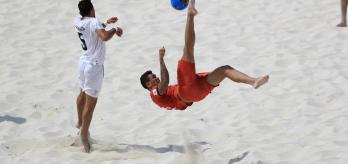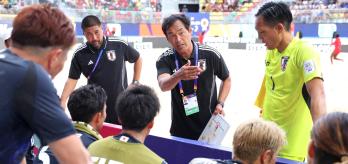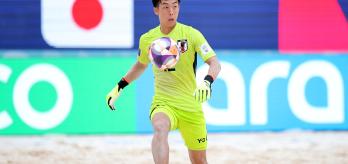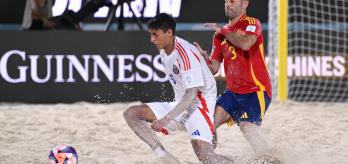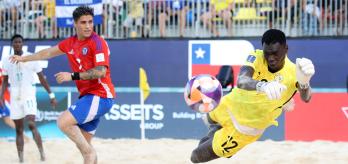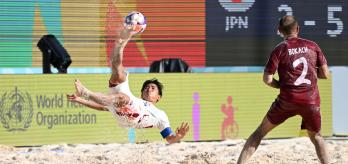As beach soccer is a small-sided game (5v5), high pressing the opposition goalkeeper involves a degree of risk. If they have the ball in their hands, it can be very risky to send one player to press, as this means one of their outfield players will be left free. The risk stems from the goalkeeper’s ability to make a high-quality throw pass into a very dangerous area.
According to Angelo Schirinzi, “A pass with the feet for the goalkeeper is much more difficult to execute accurately than one with their hands, especially when you consider they must lift the ball and have control of it in the air before making a pass. However, as we have seen in recent years, goalkeepers have become very proficient with their feet, and their distribution is really strong, so this poses a real challenge for coaches when deciding on the pressing strategies for their team.”
After FIFA Beach Soccer World Cup UAE 2024™, our Football Performance Insights Team reported that goalkeepers scored 11 goals, a new record for a FIFA Beach Soccer World Cup. They also provided 40 assists and registered no fewer than 408 attempts at goal between them so for Matteo Marrucci, these statistics means teams need different pressing strategies against different teams and against different goalkeepers.
“Sometimes a team might allow the first pass if the goalkeeper has the ball in their hands, and then, if it is played back to their feet, that can be the trigger to initiate the high press. It will also depend on the impact that each goalkeeper individually can have in a game when they are starting the build-up, based on their proficiency in distribution with their hands and feet. There is a lot to think about when a team is in the defending phase against different goalkeepers, especially in such a fast-paced game,” he explained.
During the opening games of FIFA Beach Soccer World Cup Seychelles 2025™, our TSG have been monitoring the pressing strategies of all teams and, even at this early stage, some interesting themes have emerged.
The highest proportion of Spain’s out-of-possession time (46.5%) has been in the high press from the block phase, initiating a total of 40 high pressures from the block in their opening two games. Continuing on from their aggressive approach during FIFA Beach Soccer World Cup 2024, (where they were the highest-ranked team from high press from high block), defending champions Brazil are the second-highest-performing team after the first two games.
SPAIN – Risk and reward
This element of risk versus reward is evident in Spain’s pressing strategies. In their group-stage match against Senegal, we see an example of how their high-pressing strategy proved effective.
In clip 1 below, Spain recover to their 1-3-1 defensive shape as soon as Senegal goalkeeper Osseynou Faye (12) collects the loose ball. They allow him to play the first pass from hands to left defender Ninou Diatta (2), and it is this pass that triggers Spain’s high press. Once the ball is thrown, Spain forward Kuman (10) intentionally arcs his run as he applies pressure on Faye to prevent him from playing back to his goalkeeper and to close the angle from which he can play the next pass. The angle from which the pressure comes forces Faye to control the ball on his chest, taking it away from the pressure, but in so doing, his passing lines to team-mates are closed. This pressure forces an unsuccessful pass, allowing Spain to turnover possession and begin an attack.
In clip 2, Spain adapt their pressing strategy against Chile and seek to prevent their goalkeeper, Orlando Echeverria (1), from playing forward with his feet. Marrucci highlights this below.
“When the play breaks down, Spain quickly recover to a 1-2-2 defensive shape, allowing the first pass from hands to Sebastián Bolívar’s (2) head. Immediately, Ramy Saghdani (8) presses, but interestingly, his pressing line is towards the goalkeeper, Echeverria, as he is anticipating the return pass, forcing him to take the ball in hands and not on his feet. Once the ball is in his hands, Saghdani retreats, allowing Echeverria to throw a long pass forward, which Spain clear, before forcing the ball back to the goalkeeper. As the ball goes back to him, Spain look to initiate pressure once more as he attempts to lift the ball with his feet, before retreating once he takes the ball in hands.”
Clip 3 has been selected by our TSG as a great example of the risk versus reward element of this strategy from the same game.
As Marrucci explains, “When Chile goalkeeper Echeverria (1) has the ball, Spain’s pressing trigger is activated as soon as he attempts to lift it to play with his feet. Immediately, Soleiman Batis (9) comes from the left-wing position to put pressure on him. Once he plays the pass, Batis returns to his player to press, while also cutting off the angle for Diego Opazo (6) to play forward, sending him back to his goalkeeper. Batis then presses the goalkeeper hard, ensuring he takes the ball into his hands, forcing him to throw the ball. From this perspective, the pressing strategy achieved its objective.”
At this point, the risk element comes into play, as Schirinzi explains.
“As a coach, you are constantly weighing up the risk and rewards of the strategies you employ. As we saw in clip 2 and in the first part of clip 3, Spain’s pressing strategy was deliberate in its intention to stop Echeverria from playing forward with his feet, aiming to win possession back from the long throw. However, as clip 3 progresses, he finds a free player in the final third with this throw and Chile create a very dangerous goalscoring opportunity. No strategy comes without its risks, but it is important to consider these, especially when deciding on high-pressing strategies.”
BRAZIL – High intensity
Brazil built their Beach Soccer World Cup-winning campaign in 2024 on a high-intensity game, including high pressing. As can be seen in clip 4 from their hotly contested group-stage match against last year’s runners-up, Italy, they have continued with this philosophy in 2025.
As the ball goes back to goalkeeper Gean Pietro (12) from Gianmarco Genovali (4), Brazil wing Mauricinho (11) presses, dictating the direction the goalkeeper must play, and then holds the high position. This is crucial because he could have played to the free player on the other side, but instead chooses to stay on the goalkeeper. As the ball travels back to Genovali, he receives intense pressure from Rodrigo (9), and it is the intensity and speed of this press that results in the turnover of possession. This could have resulted in a goalscoring opportunity but for some excellent counter-pressure from Italy.
BELARUS – Collective aggression
While Belarus are mid-ranked for their application of high pressures from a block, our TSG have noted the collective, coordinated and controlled nature of their aggression when operating in this phase. In clip 5, taken from their group-stage match against Japan, we see how they set up their press from the 1-2-2 system.
As goalkeeper Takeru Furusato (12) receives the ball back from Takaaki Oba (7), Belarus stalwart Ihar Bryshtel (8) presses the goalkeeper hard, cutting off the angle back to Oba and forcing it wide to Ozu Moreira (10). This triggers an aggressive press from Artsemi Drozd (4), and this, combined with Bryshtel staying high on the goalkeeper, forces Ozu to play a cross-field pass back to Oba. Yauheni Novikau (7) anticipates this pass and comes in aggressively, promptly followed in a coordinated fashion by Bryshtel and Drozd to squeeze the space, keeping the distances between them short, and boxing Oba in. With no alternative, Oba plays back to his goalkeeper, and this is anticipated by Bryshtel, who is perfectly positioned to intercept.
Summary
The application of close-range, coordinated, intense pressure allows defending teams to dictate the way their opponent’s build their play. By decreasing the time and space available for the player in possession, defenders can anticipate and influence where the next pass will go, forcing errors, negating strengths and reducing the quality of the opposing team’s possession.
When this is done high up the pitch, including applying pressure to the opposition’s goalkeeper, the rewards can be significant, resulting in possession turnovers in dangerous and advanced areas. However, by committing a player to high pressing a goalkeeper, it leaves an opposition outfield player free, which can lead to risks if the free player can be found. These are the considerations for coaches when planning pressing strategies, particularly if the opposition goalkeeper is good with their feet, either in terms of distribution or goalscoring.




